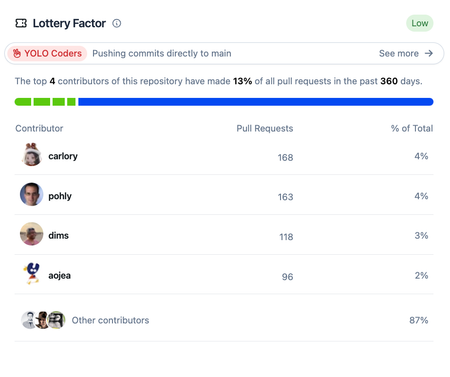
#open source
#open source community
Open Source Alchemy: How Open Source Community Contributions Turn Code into Gold
BekahHW
6 mins read

In 2006, Graydon Hoare, a 29-year-old programmer at Mozilla, opened his laptop and began designing a new computer language. His goal: to make it possible to write small, fast code without the memory bugs that plague languages like C and C++, the lead to many software crashes. He named it Rust.
Fast forward to today. Rust has become a programming phenomenon, ranking as the "most loved" language in Stack Overflow's developer survey for seven years running (as of 2023). But Hoare didn't do it alone. It was the result of thousands of contributors worldwide, each bringing their unique perspectives, use cases, and new ideas to the table.
When Mozilla sponsored and open sourced Rust in 2009, the project rapidly evolved through contributions from developers worldwide. Its welcoming culture, combined with Rust's technical innovations, created a perfect situation for open source success.
But Rust's success wasn't inevitable. Its ascent was fueled by a perfect alchemy of technical innovation and community engagement. The Rust team created an environment where contributions were valued and new contributors were welcomed.
This approach created a positive feedback loop: more contributors led to better documentation and tooling, which in turn attracted more contributors.
Comparing Open Source Approaches: TypeScript vs. Kubernetes
The TypeScript Paradox: Controlled Evolution in an Open Source World
Not all successful open source projects follow Rust's wide-open approach. Consider TypeScript, Microsoft's strongly-typed superset of JavaScript. TypeScript has become an essential part of how the modern web is built. but its development model stands in contrast to Rust's.
Microsoft maintains tight control over TypeScript's core design. While the project is open source and accepts community contributions, major decisions are typically made internally.
This approach has advantages: it ensures a consistent vision and allows for rapid, coordinated evolution of the language.
But it also has drawbacks. TypeScript's more controlled model means it might miss out on innovations that come from a more diverse contributor base. It's a trade-off between consistency and the potential for unexpected breakthroughs. We can see in the last year, they've had only 125 outside contributors.
Despite these limitations, TypeScript's success is undeniable. Its adoption has skyrocketed, and it's become the de facto standard for large-scale JavaScript projects.
Kubernetes: The Art of Scaling Community
If Rust represents the power of community-driven development and TypeScript showcases the strengths of controlled evolution, Kubernetes exemplifies how to scale an open source community.
Created inside Google but now under the Cloud Native Computing Foundation, Kubernetes has grown from a container orchestration tool into a comprehensive platform for cloud-native computing. Its success stems from an ability to balance rapid growth with stability, and to coordinate contributions from a vast, diverse community.
In the last year, we can continue to see this reflected with 870 outside contributors.
Kubernetes has a system of special interest groups (SIGs) to focus development efforts, while a steering committee ensures overall coherence. This structure allows for both specialized innovation and overall consistency.
As more people started using Kubernetes, they also built tools for it, making Kubernetes even more useful. This created a positive loop: more users led to more tools, which led to even more users. It's not just a project; it's a platform that enables thousands of developers to build and share their own tools.
The Self-Selection Factor: The Hidden Engine of Open Source
Underlying these success stories is something we need to talk about: the rate of self-selection. This open source metric measures how eagerly and frequently developers choose to contribute to a project voluntarily.
A high rate of self-selection can be a strong indication of a thriving open source project. It brings in fresh perspectives, drives innovation, and ensures the project's longevity beyond its original creators. But cultivating this isn't just about opening up a GitHub repository and hoping for the best.
Successful projects create an environment that not only allows for contribution but actively encourages it. They provide clear documentation, maintain welcoming communication channels, and find ways to encourage new contributors.
They often celebrate and recognize contributions, and create an environment that allows for a sense of ownership and community.
The impact of self-selection varies across our projects. Rust and Kubernetes have high rates, fueling their rapid evolution and diverse ecosystems. TypeScript, with its more controlled approach, has a lower but still significant rate, attracting deeply invested contributors from the JavaScript community.
The Impact of Different Open Source Strategies
The contrasting approaches of TypeScript and Kubernetes reveal several key differences in open source development. While these differences highlight various aspects of project health, it's important to remember that no single metric tells the whole story. Let's explore some of these factors:
- Innovation Velocity: Diverse contributor bases can lead to rapid adaptation and innovation, while a controlled approach may move at a more measured pace. However, a more measured pace may allow for more thorough vetting of changes, potentially leading to fewer breaking changes.
- Ecosystem Growth: A thriving ecosystem means developers are creating a wide range of add-ons and complementary software that work with the main project. A strong ecosystem can be an indicator of a project's health and adoption.
- Project Sustainability: Distributed leadership and/or contributions ensures a projects continuity even if key contributors leave, creating a low lottery factor. Specifically, we see this reflected in kubernetes:
The Rate of Self-Selection: One Open Source Metric Among Many
Among these factors, the "rate of self-selection" - how eagerly and frequently developers choose to contribute to a project voluntarily - is one important metric to consider. Here's why it matters:
- It can indicate a project's attractiveness to developers.
- It often brings in fresh perspectives and innovations.
- It can contribute to a project's long-term sustainability.
- It tends to increase the diversity of skills in the project.
- It often correlates with a strong, engaged community.
It's always worth noting that a high rate of self-selection doesn't automatically mean a project is healthy or successful. TypeScript, for instance, has a moderate rate of self-selection but is highly successful and influential. It attracts fewer but often high-quality contributions from developers deeply invested in improving the JavaScript ecosystem.
Last Thoughts
What works for one project may not work for another. The goal should be to create an environment where good ideas can flourish. As we look to the future of open source, the projects that will thrive are those that can balance innovation with stability, individual brilliance with collective wisdom, and technical excellence with community engagement. They'll be the ones that not only write great code but also build bridges between developers, contributors, companies, and communities.
In open source, every contribution is a catalyst, every pull request a possibility. As we continue to see contributions, who knows what digital gold we might create next?

BekahHW
Bekah graduated from a coding bootcamp in May of 2019 and since then has spent time as a frontend developer, started the Virtual Coffee tech community, spent time in DevRel and has continued to mom her four kids. She currently co-hosts the Compressed.fm and Virtual Coffee podcasts, lifts heavy things in her free time, & works as the Developer Experience Lead at OpenSauced.
Recent Posts

bdougie
2 mins read
OpenSauced joins Linux Foundation, making AI-powered open source analytics freely available while expanding beyond GitHub to serve the broader open so...

#kubernetes
John McBride
5 mins read
How the OpenSauced engineering team made a near-zero downtime migration to Microsoft Azure




